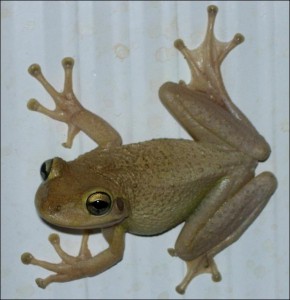
Recently I attended a conference that included a series of talks at the University of Florida’s Whitney Marine Lab. One of the talks was presented by the director of the lab, Dr. Mark Martindale, who discussed the history and mission of the lab. However, in that talk he made a comment that caught my attention.

is this a Cuban Tree Frog? Do I have to rely on DNA barconding to know for sure – before I decide to euthanize it? Could I be making a mistake?
Image by Dr. Steve A Johnson 2005.
He was discussing the work of the lab and mentioned the great diversity of microscopic life that existed in the Intracoastal Waterway right out their back door. But while discussing this he also mentioned that today’s biology students identify organisms by DNA markers. Going are the days of collecting the creatures and using taxonomic keys to identify using physical characteristics of the organism. What do I mean by this? Well, the “old timers” would wonder through the woods and shorelines, collecting specimens, and observing their physical characteristics… do they have legs? How many legs do they have? How many antennae do they possess? These “old timers” would observe the natural world, develop taxonomic keys (list of characters to help identify), have them peer reviewed, published, and occasionally updated. New microscopic techniques would alert them to mistakes they may have made and thus corrections and “re-do’s” could be done. There were specialists in this field called taxonomists. If you brought in a seashell, they would be able to identify relatively quickly. If they were confused on a few characters, they would contact their colleagues and an agreement would be reached on the proper identification. And so it went.
Today, this is not needed. The sequencing of genomes of many species have been done. The barcode method of identification by the “new school” is more accurate… as long as the sequence is correct, your identification is correct. There are fewer mistakes. Now problems like identifying what is partially digested in a fish gut can actually be done accurately. In some cases, we are learning that the classic “taxonomic tree” may have some flaws. Creatures whose physical characteristics suggest they are related, may in fact not be. We are looking at the progression of life all over again – it is an exciting time for biologists in many ways. But are we losing something by letting the “old natural history” methods go?
One example I can give is identification of a small marine creature called a lancelot. I was doing a survey of marine life at a local restoration project and collected several of these. I was trained by old school biologists and remembered there were four species of these found in our area. I looked through my old college notes to see if I could find how to tell them apart. I could not find those specific notes. So I thought I would contact local biologists for assistance… no one knew… they suggested I try this… try that… I finally decided that the only one who still knew was my old vertebrate zoology professor, Dr. Herbert Boshung. Unfortunately, Dr. Boshung – like so many other of the “old school” – had passed away.
And there I was… with a creature that I could not identify. The “new school” was not able to help. Could this be happening across the country, across the world. As the “old school” move on and the “new school” move in could we be losing a part of natural history that we won’t be able to get back? This concerned me some. To have people who should know, look at something and say “I do not know what that is” was a little disconcerting. Dr. Martindale thought we may have to “re-discover” all of this knowledge within the “new school” – start again.
I am a marine science educator who is in between the two schools. I was taught and trained by the “old school” – folks like Dr, Boshung and Dr. William Cliburn. I learned a LOT about our natural world through them and have used their “old school” methods to teach my students. The “new school” method of learning about the natural world has made wonderful discoveries and it is exciting to see what corrections will be made and what lionfish are actually eating. But I still feel the loss of the “old school” natural history is a true loss. We in Extension are often asked “can you identify this creature?” Those who have been trained “old school” can – or least to genus. “New school” not so much anymore. They can, but not by looking at it. This just seems to be a part of science education we should hold on to.
There is one place where the non-scientist interested in learning some of the “old school” methods still can… the Florida Master Naturalist Program. This program consists of three modules – uplands, wetlands/freshwater, and coastal. Participants will learn about the natural history and how to identify specific groups of creatures found in these systems – the old school way. For those interested in this I think it is a great program. It is offered through most county extension offices across the panhandle. To find out more about the program, and what modules are being offered in your area, visit http://www.masternaturalist.ifas.ufl.edu/
Posted: October 2, 2016
Category: Natural Resources, Wildlife
Tags: History, Losing, Natural, Panhandle Outdoors, Skills

